Decades – Compiling the Ultimate Library with Gordon Brown / Morgan Cry
It’s Decades. My ongoing quest to put together a library which is full of nothing but the very best books – as recommended by booklovers.
Back in January I had no books on the shelves of my Decades Library. Each week a new guest joins me and I ask them to nominate five books they want me to add to the shelves. Books which they feel all libraries should have available to allow them to be discovered by new readers.
Unfortunately for my guests I have made the selection process slightly more tricky than just nominating five books. I wanted to ensure my Decades Library would offer a great range of reading options. Therefore my guests are restricted to only selecting one book per decade from five consecutive decades – any fifty year publication span. I used to get a bit of flack about this second rule but these days it’s much more common for my guests to find clever ways to cheat when making their selections (just scroll down and take a look at Gordon Brown’s first pick).
As a sharp-eyed soul you will have noticed my guest this week is Gordon Brown. Gordon has just announced he will be penning two new books for Red Dog Press. News so fresh it didn’t make it into his introduction! The even sharper eyed reader will see one of these forthcoming books getting a wee mention in the paragraphs below.
 Gordon Brown has eight crime and thriller books published to date, along with a novella and a number of short stories.
Gordon Brown has eight crime and thriller books published to date, along with a novella and a number of short stories.
Under his new expat alias, Morgan Cry, Gordon’s latest crime thriller, ’Thirty-One Bones’, set in Spain, is published by Polygon. Available now in both the UK and the U.S. – the sequel, called ‘Six Wounds’, will be published in in May 2022.
Gordon also helped found Bloody Scotland, Scotland’s International Crime Writing Festival (see www.bloodyscotland.com), is a DJ on local radio (www.pulseonair.co.uk) and runs a strategic planning consultancy. He lives in Scotland and is married with two children.
In a former life Gordon delivered pizzas in Toronto, sold non-alcoholic beer in the Middle East, launched a creativity training business, floated a high tech company on the London Stock Exchange, compered the main stage at a two-day music festival and was once booed by 49,000 people while on the pitch at a major football Cup Final.
DECADES
Gordon is compiling the ultimate library and has asked me to contribute five books from five decades. That’s the deal, right? Okay I’ll admit up front that that is a serious challenge. Looking back on my reading am I to choose books that I loved? The one’s that I couldn’t put down. The ones I loathed (that would be a cracking list)? The ones I’ve read more than once? The ones I never finished but have tried time and time again to do so (take a bow ‘Lord of the Rings’). My own books? Fact or fiction? Or both? Do short stories get a look in? Do I ignore the rules and go for books from the same decade? Or do I just forget it all and go for the books that mean the most to me? The booky equivalents of the music albums that return to my turntable time and time again? Not necessarily the best books I’ve ever read. Nor the most technically proficient. Nor those of literary note. Good or bad the following five have one thing in common.
I love them and they fundamentally influenced my writing.
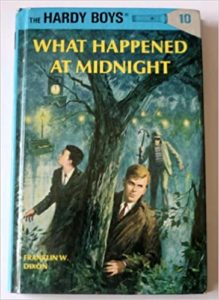 1960s – ‘What Happened at Midnight’ by Franklin W. Dixon
1960s – ‘What Happened at Midnight’ by Franklin W. Dixon
This is a Hardy Boys mystery. Okay so this is already a cheat. The book first came out in 1931 but was revised in 1967 (as were many of the books in the series to address issues with racial stereotyping and to make them more action oriented to compete with 60s TV). In addition, there is no such person as Franklin W. Dixon – the name was used to give consistency to the series – the books were written by a wide range of authors. If you want some real geekdom this book was originally penned by Leslie McFarlane and then re-written by Tom Mulvey. To add to my ‘cheatness’ quotient this is probably not my favourite Hardy Boys book – but it is the one that got me into reading in a big way. All Hardy Boys books rely on a simple premise. Two young adults, Frank (18) (16 in earlier books) and Joe (17) (15 in earlier books), whose father is a police detective, solve the criminal mystery each time. Later in the series they help their dad with his cases but in earlier books they fly solo. ‘What Happened at Midnight’ is centred on a new type of transistor that the boys are asked to steal (by dad) and keep safe. The plot involves smugglers, bi-planes and chases. That’s all you need to know on that front. What marks this out for me was the fact I read the whole thing in one afternoon. And then raided my local library for every other Hardy Boys book I could get my hands on. These books imbued me with a desire to write and to add mustard to this weird sandwich I’ve just put a Glasgow ‘Hardy Boys’ book set in 1973 out on submission.
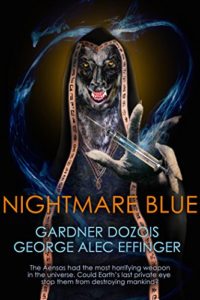 1970s – ‘Nightmare Blue’ by Gardner Dozois and George Alex Effinger
1970s – ‘Nightmare Blue’ by Gardner Dozois and George Alex Effinger
The story of an alien race who land, planning to take over earth, bringing with them a drug that is instantly addictive. One shot and you’ll die, if you don’t keep taking it. The aliens target world leaders along with the great and the good, forcing them to take the drug. Riding to humanity’s rescue is a German private investigator who teams up with a multi-limbed alien slave to rid the planet of this evil threat. Go on tell me you don’t want to read it – I have, at least half a dozen times, maybe more. I have never been able to put my finger on why this book hooks me. It’s not famous, nor is it notorious. It’s not the best written book. Nor is it without its flaws. I’ve only met one other person who has read it and they thought it was ‘okay’ – given I’d put them on to it this was a better reaction than I thought they would have. I’m convinced that the drug that is so central to the story had somehow been infused into the pages of my copy and that’s why I need a regular fix. It still resonates with me to this day. A book populated with outsiders, misfits, underdogs fighting the odds, battling the baddies. Individuals thrown into situations that they are ill prepared for. Both those sentences could sum up every book I’ve written. That’s how influential this book is to me.
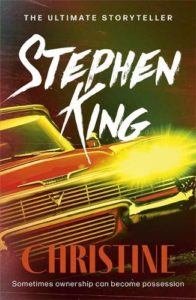 1980s – ‘Christine’ by Stephen King
1980s – ‘Christine’ by Stephen King
The start of my ‘on/off’ love affair with Mr King. This takes me back to the summer of 1983 when I was working in a bar on the shores of Loch Lomond. The hours were long, the customers demanding and time off limited. When things were quiet we were allowed to read a book. My problem was that once I started Christine I could be found reading in the back cellar when things were the polar opposite of quiet. This is a story set in Libertyville, Pennsylvania in 1978 where two school friends, Arnie and Dennis, stumble upon a wreck of a car, a 1958 Plymouth Fury. Owned by a miserable old git called Roland D. LeBay, he agrees to sell the car to the boys for $250. Only the car isn’t quite what it seems (is any inanimate object in a King novel?). Arnie becomes obsessed with the car and works on it to bring it back to its former glory. When the car starts killing people (of its own volition) poor Arnie is in the frame with the local detective. This was considered King’s first return to a fully-fledged supernatural horror novel since the The Shining but to me the book is wonderful a tale of small-town America. Of a relationship between an old man and a young boy and what true obsession can do to a person and those around them. It’s all about the characters – and that sticks with me in my own writing. Oh, and it does feature a haunted car. A theme he came back to in my favourite King book ‘From a Buick 8’.
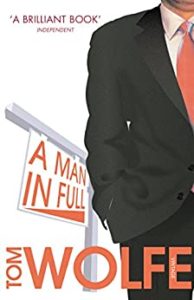 1990s – ‘A Man in Full’ by Tom Wolfe
1990s – ‘A Man in Full’ by Tom Wolfe
The opposite of a rags to riches story in every way possible. Take a man who has everything and is stretching for even more and then we watch as it all unravels. Set in high society Atlanta and told from various points of views this was Tom Wolfe’s second novel, eleven years after the monster that was ‘Bonfire of the Vanities’. I love the set pieces in this book. I borrowed the idea of naming each chapter for my own books from this work. My favourite being ‘The Saddlebags’ – a ‘breakfast’ meeting where Charlie Croker meets with his bankers, believing that, despite the problems his new vanity project is facing, he is set fair to make more money. Only to discover that the people in the room are no longer friends but Rottweilers – out to disabuse him of the notion that he is in control. The Saddlebags refers to the sweat stains that start under Charlie’s armpits as he realises how much trouble he is in. As the meeting goes south and the bankers set upon him, the stains spread across Charlie’s shirt and when they meet in the middle of his chest the cry of ‘Saddlebags’ goes up and the Charlie is sunk and the bankers own him. A story of greed, excess, entitlement and written in a way that I aspire to.
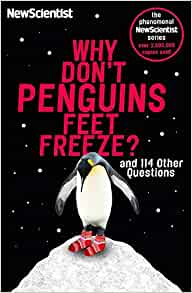 2000s – ‘Why Don’t Penguins Feet Freeze’ – The New Scientist
2000s – ‘Why Don’t Penguins Feet Freeze’ – The New Scientist
In the New Scientist magazine there is a column called ‘The Last Word’. People write in with questions and scientists (and others) write in with answers. Often disagreeing with each other. Back in 2005 New Scientist decided to take the correspondence from over the years and bundle it into a book. The first book being ‘Does Anything Eat Wasps’. As the title of the books suggest the questions are anything but ordinary – take the other books in this series ‘Do Polar Bears Get Lonely?’, ‘Why Can’t Elephants Jump?’, ‘Why Are Orangutans Orange?’ and ‘Will We Ever Speak Dolphin?’ and you get the idea. Each book has a hundred odd questions loosely ordered by subject matter. And the beauty is that few questions have a definitive answer. ‘Why Don’t Penguins Feet Freeze’ got me into what I call my ‘chewing gum for the mind’ books. I always have one on the go. At the moment it’s the ‘QI Book of the Dead’. They are my ‘escape’ books. As leftfield from crime and thrillers as I can get. Birthdays and Christmases refill my ‘nonsense’ larder as my wife and kids buy me a never-ending supply. I’m looking at one of my book shelves and can see books entitled – ‘How Much Poo Does An Elephant Do’, ‘Usefully Useless – Everything You Didn’t Learn at School’, ‘How To Live Forever and 34 Other Really Interesting Uses of Science’, ‘The World’s Greatest Mistakes’, ‘Why Does E=MC2?’, ‘Elephants on Acid and Other Bizarre Experiments’ (What is it about elephants?), ‘Go Figure – Things you Didn’t Know You Didn’t Know’, ‘The Worst Case Scenario Handbook’ – and so on. But, in truth, these books, apart from allowing me to lose myself, are simply the dogs bollocks for providing the grist for my creative writing mill.
I would never have expected Why Don’t Penguins Feet Freeze? to make its way into my Decades Library but it’s a book I also loved to read. My wife and I both read our way through all the books The New Scientist released – me for the quirky questions and her for the “sciency bits”.
The non-fiction shelves of my Library are not as busy as the fiction ones at this time. Perhaps in future more non-fiction books will make their way through the doors and into the Decades Library? The only way to find out is to keep reading.
DECADES WILL RETURN